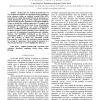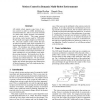3955 search results - page 89 / 791 » Comparing the Power of Robots |
ROMAN
2007
IEEE
15 years 4 months ago
2007
IEEE
—This paper proposes a novel method of learning a users preferred reward modalities for human-robot interaction through solving a cooperative training task. A learning algorithm ...
ICRA
2005
IEEE
15 years 3 months ago
2005
IEEE
– In this paper, we evaluate the performance of two candidate formulations for distributed motion planning of robot collectives within an Artificial Potential Field (APF) framewo...
ROBOCUP
1999
Springer
15 years 2 months ago
1999
Springer
All mobile robots require some form of motion control in order to exhibit interesting autonomous behaviors. This is even more essential for multi-robot, highly-dynamic environment...
135
click to vote
IJCAI
1989
14 years 11 months ago
1989
This paper explores the realization of robotic arm motion planning, especially Findpath Problem, which is a basic motion planning problem that arises in the development of robotic...
CEC
2010
IEEE
14 years 11 months ago
2010
IEEE
For any embodied, mobile, autonomous agent it is essential to control its actuators appropriately for the faced task. This holds for natural organisms as well as for robots. If sev...


